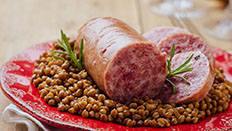Meats and Sausages
Cotechino Modena
In many ways Cotechino Modena PGI is similar to Zampone Modena PGI as both sausages use large percentage of pork skin as an ingredient. The main difference is that Cotechino looks like a sausage and Zampone which is stuffed into whole pig’s trotter starts an immediate conversation, at least for consumers who never have seen it before. This method of making pork sausage originated in Modena and later spread to other regions of central and northern Italy. The sausage exhibits a characteristic taste. The sausage makers' technical skills, traditionally handed down between those in the trade, are an essential feature of the product, and even today its characteristics are shaped by the importance of environmental and human factors.
| Meats | Metric | US |
|---|---|---|
| Lean pork* | 500 g | 1.10 lb |
| Pork belly, jowl fat | 150 g | 0.33 lb |
| Pork skin ** | 350 g | 0.77 lb |
Ingredients per 1000g (1 kg) of meat
| Salt | 28 g | 4.5 tsp |
| Cure #1 | 2.0 g | 3/4 tsp |
| Pepper | 2.0 g | 1 tsp |
| Cinnamon | 1.0 g | 1/2 tsp |
| Cloves, ground | 0.3 g | 1/8 tsp |
| Garlic | 1.0 g | 1/4 clove |
| Red wine | 5 ml | 1 tsp |
Instructions
- Grind cold meat and fat through 10 -12 mm (3/8 – 1/2”) plate.
- Slice skin into strips and grind through 3-5 mm (3/16-1/4”) plate.
- Mix ground meat, fat and skin with all ingredients.
- Hold (optional step) for 12 hours (overnight) in refrigerator.
- Stuff into 60 – 80 mm hog or beef middles or synthetic fibrous casings making 25 cm (12”) sections.
- Place in refrigerator and fully cook before serving. Cotechino is made as a fresh or cooked sausage. Cotechino is served hot. If it is cooked and left for later in refrigerator, it must be heated again what takes a considerable amount of time. The secret to cooking Cotechino is to pierce it not with a needle but with a fork in a few places all around. The needle is too small and the holes will close themselves again. Cooking Cotechino: place sausage in cold water, bring to a boil and simmer at no more than 80° C (176° F) at low heat for 2-3 hours. That, of course, depends on diameter of the sausage. When cooked, the Cotechino must be soft and supple to the touch.
Notes
The protected designation of origin ‘Cotechino Modena’ must appear on the label in clear and indelible characters, distinctly separate from any other writing. It must be followed immediately by the words ‘Indicazione geografica protetta’ (protected geographical indication) and/or the abbreviation ‘IGP’ (PGI). It is forbidden to add any description that is not expressly provided for.
* Meat rich in connective tissue should be selected such as front leg or foot, head meat, or from the neck area.
** pork skin may come from trimming jowls, shoulder, belly and ham cuts. It is of crucial to remove any bristle (hair) from the skin and to scrape off any remaining fat on inside.
Sodium nitrite may be added at <140 ppm (parts per million) which is about 2.0 g ¾ tsp of Cure #1 per 1 kg of meat. Cotechino is neither smoked nor extensively dried so the only benefit of adding sodium nitrite in home will be slightly stronger color.
Cotechino Modena sausage is cylindrical in shape, cooked and easy to slice, with the firm evenly grained pink slices maintaining their shape.
Cotechino goes well with both mashed potatoes and stewed lentils during the Christmas holidays.
The geographical area of production.
Cotechino Modena is produced within its traditional geographical production area, which covers the entire territory of the following Italian provinces: Modena, Ferrara, Ravenna, Rimini, Forlì-Cesena, Bologna, Reggio Emilia, Parma, Piacenza, Cremona, Lodi, Pavia, Milano, Monza-Brianza, Varese, Como, Lecco, Bergamo, Brescia, Mantova, Verona and Rovigo.Production
Meat: Cotechino Modena is made from a mixture of pork meat, pork fat, and pork skin.
Ingredients: salt, whole pepper and/or crushed. The following ingredients are also added: natural flavorings, spices and herbs, sugar and/or dextrose and/or fructose, sodium and/or potassium nitrite (maximum 140 parts per million), ascorbic acid and its sodium salt, wine, water. Liquid smoke is not allowed. The mixture is stuffed into natural or artificial casings.
Processing: preparing raw materials, mincing, mixing and filling into natural or artificial casings, followed by drying if the product is sold fresh and any pre-cooking and appropriate heat treatment if the product is sold cooked.


















